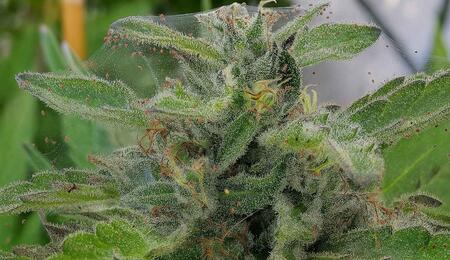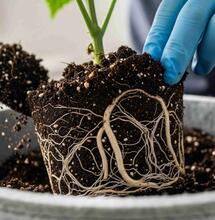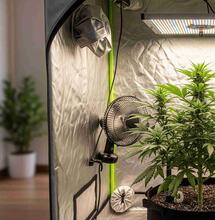Cannabis Plants and Pest Control

Have you ever noticed that one day you take a closer look at your cannabis plants, and those perfectly green leaves are showing signs of insect damage? There is nothing worse as a grower than discovering that you have unwanted guests in your grow room, and it is just a matter of time until things get worse.
In this article, I will explain the various types of cannabis plant pests that you may encounter as a grower, their preferred environments, and the signs to look out for. As well as how to get rid of them, a choice of predators that you can use to fight them off and my top tip for each insect problem, to ensure your plants stay as healthy and happy as possible under your watch
The Different Types of Cannabis Pests
Aphids
They come in a variety of colours, ranging from yellow to black, green, red, and grey. They are asexual, meaning that females do not require males to reproduce. They do not lay eggs; instead, the female aphids give birth to live youngsters. They are found on the undersides of cannabis leaves in large groups, so they are not so easy to initially spot. Aphids will eat a cannabis plant leaf by sucking sap from the leaves, stems and roots.
What Environment Do Aphids Prefer?
Aphids thrive in warm, moist environments where healthy cannabis plants are growing. These pests prefer to be close to tender and healthy vegetation, as well as older, weaker plants. They will thrive in a grow room when the temperature is between 20°C and 25°C, which encourages rapid reproduction. In contrast, their growth and reproduction rate will significantly decline when the temperature is much colder, at 10 degrees Celsius.
Signs of Aphid Damage
- Wilting cannabis leaves
- Slowed plant growth
- A honey dew residue
- Dehydrated plants
- Root discolouration
- Yellowing leaves
How to Get Rid of Them
- Physically remove them using a spray
- Soapy water to dehydrate them
- Using a neem oil spray
- Insecticidal soap
- Natural predators
Natural Predators for Aphids
- Ladybugs
- Parasitic wasps
- Lacewings
- Hoverflies
- Minute Pirate Bugs
- Damsel Bugs
My Top Tip for Solving an Aphid Problem
Aphids can become a serious problem, and the sooner you can get rid of them, the better. Using soapy water is an effective way to deter them, as it dissolves their waxy outer coating and causes them to become dehydrated. If you notice that you have a large aphid population, then introduce any of the natural predators covered in the list below. Defoliating cannabis leaves can also help remove large populations of aphids.
Thrips
These tiny insects are also asexual, meaning the female can lay eggs without mating. Thrips will lay their eggs inside plant tissue. They are slender and range in length from 0.5 to 2.5 mm, making them difficult to spot on cannabis plants, and typically hide on the undersides of leaves. Their larvae are wingless and similar to thrips; they will suck the sap from cannabis leaves. Thrips can be pale yellow, brown, black, or orange, and may possess a red tint.
What Environment Do Thrips Prefer?
Thrips prefer environments that are warm and dry, ranging from 20 to 37 degrees Celsius. They can survive when the temperature is much colder, closer to 10 degrees Celsius; however, their lifecycle dramatically slows down.
Signs of Thrip Damage on Cannabis Plants
- Tiny silver or bronze spots on the leaf.
- They leave behind tiny black faeces.
- Causes leaves to become brittle.
- Causes leaves to curl.
- Scarring or discolouration
- Paper-thin, weak leaves
How to Get Rid of Them
- Spray them off using water
- Insecticidal soap
- Neem oil spray
- Diatomaceous earth on top of the soil
- Natural predators
Natural Predators for Thrips
- Minute pirate bugs
- Rove beetles
- Lacewing larvae
My Top Tip for Solving a Thrip Problem
Avoid overwatering your growing medium, and try using a spray made from neem oil and soap. You can spray the leaves, which will suffocate the thrips; however, do not spray the buds. If you notice a bad thrip problem during the flowering period, invest in predators for thrips.
Spider Mites
Spider mites are easily the most difficult cannabis pest to combat and range in colour from red, orange, green, brown, or yellow, making them challenging to spot. A female spider mite will lay 60 eggs at a time, and from that number, 50 will be female, which means before you know it, the spider mite population has reached the thousands.
The eggs, when hatched, turn into adults within 10 days, so you are racing against the clock when it comes to spider mites. They can rapidly infect a cannabis plant, leaving a trail of damage on the leaves and establishing delicate webs on the tops of the buds and close to the stem.
What Environment Do Spider Mites Prefer?
They thrive in warm and dry grow room conditions, which is why they are quick to reproduce during the flowering period indoors, when humidity levels are lower and temperatures are below 50 degrees Celsius. Spider mites can withstand temperatures ranging from 10 to 40 degrees Celsius, and the hotter the environment, the faster they reproduce. They will typically inhabit sick and weaker cannabis plants.
Signs of Spider Mite Damage
- Tiny yellow spots on the leaf
- Causes leaves to turn bronze.
- Silk webs form on the buds and stem
- Wilting and weak leaves.
How to Get Rid of Them
- Spray them off the plant using water
- Insecticidal soap
- Neem oil spray
- Natural predators
Predators for Spider Mites
- Ladybugs
- Minute Pirate Bugs
- Lacewings
My Top Tip for Solving a Spider Mite Problem
Based on my experience, spider mites are the worst of the three insects covered in this article. You must act fast when dealing with a spider mite issue, so introduce natural predators immediately. They can reproduce extremely quickly, and oftentimes, a grower unknowingly introduces spider mites into their garden from clones.
How to Quarantine Your Cannabis Plants
If you have a second vegetation tent which contains new cannabis seeds, clones or a mother plant, then keeping your plants separated from an infested grow room will be advantageous. In the meantime, try to resolve the issue using any of the methods covered above before introducing your healthy plants into the grow space. As a worst-case scenario, be prepared to discard your infested plants.
Using Diatomaceous Earth
Diatomaceous earth is a white, powdery substance made from the fossilised skeletons of tiny aquatic organisms. It is basically silicon dioxide, which has sharp and abrasive edges when viewed at the microscopic level, and causes any insects that come into contact with it to cut and sucks the moisture out of their exoskeleton. Diatomaceous earth can be applied to the tops and undersides of leaves in powder form. It can also be used on the top layer of the growing medium, providing a cost-effective way to control pests.
Neem Oil Sprays
Neem oil is a natural pesticide derived from the neem tree. It has a thick and dense consistency and is dark yellow in colour. It has a pungent, sulfuric and garlic-like smell and possesses the ability to suffocate insects and their larvae. If using neem oil, it is best to spray the tops and undersides of your cannabis plants in vegetation every 36-72 hours and check the progress.
My Final Thoughts on Pest Control
The best advice I can give you as a home grower dealing with a thrip, aphid or spider mite infestation is to act fast! Breaking the insect's reproduction cycle is key to keeping their population down to a minimum. Avoid using chemical-based pesticides; instead, opt for organic solutions whenever possible.
If your plants are in the flowering stage, be very careful when applying the spray and avoid letting the buds come into contact with any spray. I strongly recommend using predatory insects and monitoring your plants for damage daily. Neem oil is a strong-smelling, thick liquid that can easily block the spray nozzle, so start with a mild solution if you choose to use neem oil.



